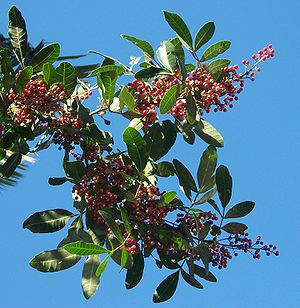Brazilian pepper tree
| Brazilian pepper tree | ||||||||||||
|---|---|---|---|---|---|---|---|---|---|---|---|---|

Brazilian pepper tree ( Schinus terebinthifolia ) |
||||||||||||
| Systematics | ||||||||||||
|
||||||||||||
| Scientific name | ||||||||||||
| Schinus terebinthifolia | ||||||||||||
| Raddi |
The Brazilian pepper tree ( Schinus terebinthifolia ), also called Christmas berry , belongs to the sumac family (Anacardiaceae).
description
The Brazilian pepper tree grows as an evergreen shrub or small tree and reaches heights of up to about 9-10 meters, rarely a little more. The trunk diameter reaches 30–60 centimeters. It has a rounded crown and alternate, unpaired pinnate leaves with often slightly winged, somewhat hairy rachis. The mostly sessile, rounded to pointed 7-13, bald leaflets are mostly with entire margins or sometimes more or less notched or serrate in the upper part. They are up to 5–7.5 centimeters long and ovate to obovate. The young leaves are more or less serrated. The shiny foliage gives off a peppery smell when rubbed or broken.
The Brazilian pepper tree is dioecious diocesan . The very small, yellowish-white and short-stalked, five-fold, functionally unisexual flowers with a double bloom envelope are arranged in multi-flowered, richly branched, shorter panicles and are formed in summer. There are 10 stamens or small staminodes in the female flowers as well as an upper ovary with a short stylus or a small pestle in the male flowers and a discus each. Small green drupes later develop from them , which develop into the conspicuous, red, long-lasting, smooth and 4–5 millimeter large, single-seeded fruits with minimal stylus remains during ripening. The flattened, sculpted, red-brown and pointed stone core is up to 3 millimeters in size.
The number of chromosomes is 2n = 28.
pharmacology
Schinus terebinthifolia contains 3.3 to 5.2% essential oil . This mainly consists of the monoterpenes α- and β- phellandrene , limonene , p-cymene , silvestrene , myrcene , α- pinene , trans-terpin, perillaaldehyde , 3-carene and carvacrol . The fruits also contain cardanols , their concentration fluctuates between 0.03% (in Réunion ) and 0.05% (in Florida ). Irritation of the mucous membranes may occur some time after consumption. Skin tests with Cardanol have shown strong skin irritation with a long latency period . It is believed that vapors emanating from the fruit can cause headaches, swelling of the eyelids, and respiratory depression. Although, according to Schwenker & Skopp, after self- tests and use as a spice, the plant did not cause any irritation, it should be regarded as poisonous.
use
The fruits of this Brazilian spice plant are used as a spice under the name "pink pepper", "rosé pepper" or "pink berries", but they are not real pepper , but instead of colored pepper (black, white and green) for optical reasons mixed with rare red pepper . They have a mildly aromatic taste . The fruits are often used as Christmas decorations, which is what the second name "Christmas berry" is based on.
The tree carries a gum resin , aroeire resin or American mastic such as the Peruvian pepper tree ( Schinus molle ).
distribution
The Brazilian pepper tree is native to Central and South America. In the USA, the species, which was imported to Florida as an ornamental plant in 1840, is now undesirable because it is overgrown and overgrown with natural habitats. Large areas of the Everglades are now pure pepper tree stocks and millions of dollars are being invested in an attempt to free areas from this plant again. Owning or planting is illegal in Florida .
The trees are sensitive to frost and need a minimum temperature of 5 ° C.
See also
Individual evidence
- ↑ Schinus terebinthifolia at Tropicos.org. In: IPCN Chromosome Reports . Missouri Botanical Garden, St. Louis
- ^ Lutz Roth, Max Daunderer , Kurt Kormann: Poison Plants - Plant Poisons, 6th Edition, NIKOL Verlag, Hamburg, 2012. ISBN 978-3-86820-009-6 .
Web links
- Schinus terebinthifolia at Useful Tropical Plants.
- Schinus terebinthifolia in CABI Invasive Species Compendium.
- Gernot Katzer's website on "Pink Pepper" .



